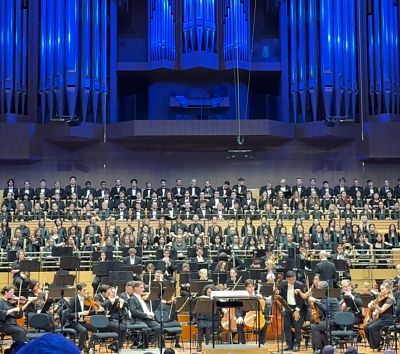
Queensland Symphony Orchestra Verdi Requiem
Click here if you liked this article 18 ![]()
https://www.qpac.com.au/whats-on/2025/qso-verdi-requiem
Date Reviewed: 04/10/2025
Verdi Requiem
A celestial storm of sound, led by Umberto Clerici and the Queensland Symphony Orchestra
When Verdi wrote Messa da Requiem, he wasn’t merely content to whisper prayers to God, he wanted to thunder at the gates of Heaven. At QPAC, under the passionate direction of conductor Umberto Clerici, Queensland Symphony Orchestra joined forces with the Brisbane Chamber Choir Collective and four powerhouse soloists to deliver a performance so magnificent it seemed to open those celestial gates.
Right from the opening measures, it was clear this was no polite memorial mass. It was theatre in sacred robes; a great emotional architecture built from sound, light, and faith in music’s power to move mountains.
A Conductor Who Paints with Volume and Vision
At the podium, Umberto Clerici conducted not merely with his hands but with his whole being. His style is both precise and poetic; his baton sculpting the air, commanding dynamic contrast with painterly finesse. Under his direction, the orchestra moved like a single living organism. One moment, the hall quivered under the apocalyptic fury of the Dies irae; the next, he would pare it back to a thread of trembling violins, as if the soul itself were whispering.
Clerici’s gift lies in how he channels energy: his conducting lifts others up. You could feel his passion ripple outward, igniting the players, inspiring the singers, and holding the audience in rapt attention.
Four Voices, One Soul
The soloists brought a vocal palette that shimmered with variety and emotional nuance. Eleanor Lyons (soprano) soared like sunlight through stained glass. Her tone was angelic and crystalline, yet charged with feeling, and her expressive face made every plea to the divine feel heartbreakingly personal. Deborah Humble (alto) anchored the ensemble with a voice of mahogany richness, her lines shaded with experience and reverence. There was a haunting gravitas to her delivery that made the Lacrymosa ache.
Matteo Desole (tenor) offered purity and poise, his voice cutting cleanly through the orchestral tempest, his diction faultless, his phrasing imbued with elegance. Warwick Fyfe’s bass was a cathedral of sound; resonant, warm, and profoundly human. He didn’t just sing the Requiem, he seemed to feel it in every fibre, responding to others’ performances even when silent. His empathy and expressiveness made him a magnet for the audience’s gaze; you couldn’t help but feel every note pulse through him.
A Choir That Could Wake The Dead (and Bless Them Again)
The Brisbane Chamber Choir Collective, under Graeme Morton’s impeccable direction, were nothing short of transcendent. Their sound was rich, radiant, and unified, enveloping the hall like a wave of light. At times, they were a whispering cloud of spirits; at others, a celestial army.
Morton ensured the choir’s phrasing carried the same theatrical intelligence Verdi himself intended: the grandeur of opera, the reverence of ritual, the intensity of prayer. Their harmonies were so glorious they bordered on overwhelming. It was the kind of beauty that presses tears from your eyes before you realise it’s happening.
Orchestra as Divine Engine
The Queensland Symphony Orchestra matched that vocal splendour with playing that was both fierce and sensitive. Every section from the sombre, heartbeat basses to the celestial winds and searing brass seemed to breathe as one. The offstage trumpets of the Tuba mirum were spine-tingling, like echoes of eternity itself. I loved the choice to place them in balconies above the audience; it added to the theatricality and drama.
The QSO played as though their instruments were extensions of a single cosmic pulse, and the result was nothing short of sublime. There was immense control in the chaotic moments in Verdi’s work. Each crescendo was sculpted with care, each silence filled with tension.
A Requiem That Lives
Verdi’s Requiem is a paradox. It’s a mass for the dead that pulses with life, a sacred text sung with operatic fire. It asks whether fear and faith can coexist, whether humans can find peace in divine mystery. On this occasion, the answer was a resounding, echoing yes that filled the Concert Hall and the hearts within it.
By the final Libera me, time itself seemed to stand still, and then came the eruption, a standing ovation that stretched on and on, five minutes, ten maybe. Every clap, every “bravo,” every teary “woo hoo” felt like a collective act of gratitude for the soloists, for Verdi, for Clerici, for every artist who gave everything on that stage.
Reviewed by Kitty Goodall